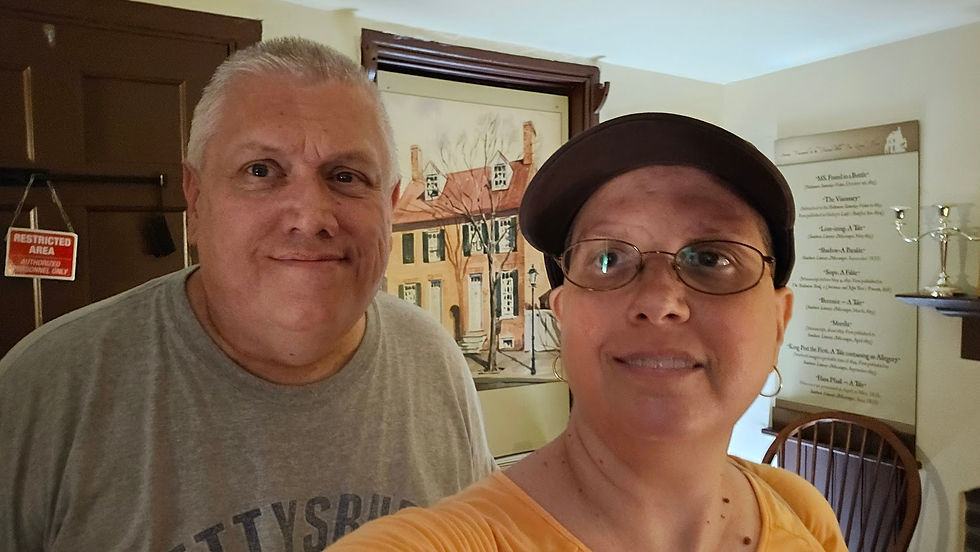Austin Log Cabin - Almost Destroyed
- PANICd Paranormal Videos
- Jul 5, 2019
- 4 min read
Updated: Sep 5, 2022
We have visited the Austin Log Cabin on several occasions so it is hard to specify a certain date that were were there at the location. This building is not too far from where we live, and it is always interesting to visit.

The Austin Log Cabin, is named for Calvin Austin, a Connecticut Land Co. agent in charge of distributing the land in this part of Ohio. It was Austin who sold 150.5 acres of land that the cabin sits on to John Packard on April 29, 1814, for $500. Packard and his second wife, Mary, and their 10 children had migrated to Austintown from Massachusetts.
Some Local historians believe Packard built the log cabin that is seen on the property today because of steeple notches on the corners of the logs and this building design was not used after 1824. Others believe it was built in 1802 by Calvin Austin himself, though the deed from 1814 does not mention a cabin being on the property.
For those who would like to visit the cabin, it is located on Racoon Road in Austintown.
History of the Building
The building is in Township 2 North, Range 3 West. It is a two story, 20 ft x 25 ft log building with clay and straw chinking. It was originally two rooms - one on each floor. Over time, separators were added to make additional rooms on the second floor. At some point in history, a cellar was added as well as it is not considered to be the same age as the structure above. Later additions of a kitchen, porch, ad bathroom were also added, though the kitchen and porch were subsequently removed in order to restore the building.
The Packards owned the property for about 14 years. Packard’s wife Mary died in 1826; John died in 1827. Their son William would inherit the land and 1828, he would sell the log house and 30 acres to Samuel Dorwat for $150.
In 1829, Dorwat sold 10 acres with the house on it to Henry and Polly Lawrence for just $50. When Lawrence died in 1845, his wife and heirs sold the property to Abraham and Rebecca Mauer Dustman for $406.
The Dustman’s added a barn and sold the property in 1850 to Henry and Margaret Wehr for $510.

Wehr added a hog shed and dug two wells; one for human use and the other for their livestock. Henry's nephew Levi and his wife, Emma Wehr, eventually took control of the cabin from Henry.
In 1910, the barn burned to the ground, and Levi Wehr built a new barn. Archeologist Dr. John White of Youngstown State University, whom I happened to participate in two archaeological digs with, discovered the barns' foundations during an archeological dig at the cabin in 1976-77. In the 1940s, The house was acquired by Willard Wesley Stricklin who reportedly dug out a root cellar below the kitchen.
The house was occupied from 1948 to 1963 by Joseph Hanko. Hanko dug out cellar under main house and added the small bathroom extension.
Almost Demolished

After the Hanko family relinquished the building, The house sat vacant until 1973 when it was acquired by St. Andrew's Episcopal Church which owned the adjacent property acquired a 99 year lease from Austintown and planned to demolish the building. When they began demolishing it by removing the artificial brick and siding, they discovered the early log beams and stopped the demolition realizing the historical possibilities that the building could be holding.
The cabin was registered as a national historic landmark July 30, 1974.
On Sept. 18, 1975, a road toll was instituted to raise funds for restoring the cabin. It was deemed a fundraiser which basically involved people standing at the busiest intersection in Austintown the intersection of Raccoon Road and Mahoning Avenue, and collecting money from drivers in cars stopped at the red light.
The road toll, along with donations, bake sales, book sales, a Dance and a grant, raised $50,000 to restore the log cabin.
Volunteers then with the help of a historic architect, removed parts of the building that were not original such as the porch and kitchen, replaced the cabin's roof with wood shake, removed interior walls and replaced windows with panes of glass from a 100-year-old schoolhouse. They also resealed the logs with preservatives and replaced the chinking with a cement mixture meant to stimulate the original clay, straw, mud and rock clinking and built a fireplace using century-old brick and mantel from a barn beam and adding a furnace and new plumbing.
As part of the bicentennial celebration, the newly restored cabin was dedicated July 4, 1976.
Today, the Austintown Historical Society maintains the Austin Log Cabin and is responsible for its maintenance. They provide free tours of the cabin on the first Sunday of every month and have furnished the Cabin through donations including a bed slept in by Frank Ohl, a historical figure in Austintown, primitive tables, and Ohio Bicentennial memorabilia. The basement houses antique farm tools. Other items of interest in the building are several artifacts collected during the archaeological excavations of the cabin grounds as well as photographs from the restoration.
Let us know down in the comment section below if you have visited the cabin in the past, and if you knew that it was almost torn down.


















































Comments